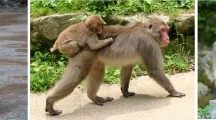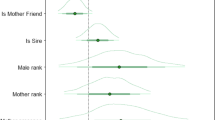Abstract
Experiments on five mother-infant pairs of Japanese monkeys (Macaca fuscata)living together in a captive group were conducted during the first 12 weeks after birth in order to assess the time at which infants begin to discriminate their own mothers from other adult females. After removal from their social group, infants exposed to their mothers and three unfamiliar adult females at a distance of 150 cm failed to orient visually toward their mothers. However, when the infants were allowed to approach the four females, they responded preferentially to their mothers during the third month of life. We concluded that by 8–12 weeks of age, infant Japanese macaques are able to discriminate between their mothers and other adult females.
Similar content being viewed by others
References
Berman, C. W. (1980). Mother-infant relationships among free-ranging rhesus monkeys on Cayo Santiago: A comparison with captive pairs.Anim. Behav. 28: 860–873.
Boothe, R. G., William, R. A., Kiorpes, L., and Teller, D. Y. (1980). Development of contrast sensitivity in infantMacaca nemestrina monkeys.Science 208: 1290–1292.
Cheney, D. L., and Seyfarth, R. M. (1980). Vocal recognition in freeranging vervet monkeys.Anim. Behav. 28: 362–367.
Hansen, E. W. (1976). Selective responding by recently separated juvenile rhesus monkeys to calls of their mothers.Dev. Psychobiol. 9: 83–88.
Hinde, R. A., and Atkinson, S. (1970). Assessing the roles of social partners in maintaining mutual proximity, as exemplified by mother/infant relations in monkeys.Anim. Behav. 169–176.
Hinde, R. A., and Spencer-Booth, Y. (1967). The behaviour of socially living rhesus monkeys in their first two and a half years.Anim. Behav. 15: 169–196.
Hinde, R. A., Rowell, T. E., and Spencer-Booth, Y. (1964). Behaviour of socially living rhesus monkeys in their first six months.Proc. zool. Soc. Lond. 143: 609–649.
Itoigawa, N. (1973). Group organization of a natural troop of Japanese monkeys and mother-infant interactions. In Carpenter, C. R. (ed.),Behavioral Regulators of Behavior in Primates, Bucknell University Press, Lewisburg, Pa., pp. 229–250.
Jensen, G. D. (1965). Mother-infant relationship in the monkeyMacaca nemestrina: Development of specificity of maternal response to own infant.J. comp. physiol. Psychol. 59: 305–308.
Jensen, G. D., and Tolman, C. W. (1962). Mother-infant relationship in the monkey,Macaca nemestrina: The effect of brief separation and mother-infant specificity.J. comp. physiol. Psychol. 55: 131–136.
Kaplan, J. N., Winship-Ball, A., and Sim, L. (1978). Maternal discrimination of infant vocalizations in squirrel monkeys.Primates 19: 187–193.
Kaufman, I. C., and Rosenblum, L. A. (1969). The waning of the mother-infant bond in two species of macaques. In Foss, B. M. (ed.),Determinants of Infant Behavior, Methuen, London, pp. 41–59.
Kaufmann, J. H. (1966). Behaviour of infant rhesus monkeys and their mothers in a free-ranging band.Zoologica 51: 17–27.
Kawamura, S. (1958). Matriarchal social ranks in the Minoo-B troop: A study of the rank system of Japanese monkeys.Primates 1: 149–156.
Koyama, N. (1967). On dominance rank and kinship of a wild Japanese monkey troop in Arashiyama.Primates 11: 335–390.
Redican, W. K. (1975). Facial expressions in nonhuman primates. In Rosenblum, L. A. (ed.),Primate Behavior, Vol. 4, Academic Press, New York, pp. 103–194.
Rosenblum, R. A. (1971). The ontogeny of mother-infant relations in macaques. In Moltz, H. (ed.),Ontogeny of Vertebrate Behavior, Academic Press, New York, pp. 315–367.
Rosenblum, L. A., and Alpert, S. (1974). Fear of strangers and specificity of attachment in monkeys. In Lewis, M., and Rosenblum, L. A. (eds.),The Origin of Fear, John Wiley, New York, pp. 165–193.
Rosenblum, L. A., and Alpert, S. (1977). Response to mother and stranger: A first step in socialization. In Chevalier-Skolnikoff, S., and Poirier, F. E. (eds.),Primate Biosocial and Ecological Determinants, Garland, New York, pp. 463–477.
Rowell, T. E., Hinde, R. A., and Spencer-Booth, Y. (1964). “Aunt”-infant interaction in captive rhesus monkeys.Anim. Behav. 12: 219–226.
Simons, R. C., and Bielert, C. F. (1973). An experimental study of vocal communication between mother and infant monkeys (Macaca nemestrina).Am. J. phys. Anthrop. 38: 455–462.
Simons, R. C., Bobbit, R. A., and Jensen, G. D. (1968). Mother monkeys’ (Macaca nemestrina) responses to infant vocalizations.Percept. motor Skills 27: 3–10.
Author information
Authors and Affiliations
Rights and permissions
About this article
Cite this article
Nakamichi, M., Yoshida, A. Discrimination of mother by infant among Japanese Macaques (Macaca fuscata). Int J Primatol 7, 481–489 (1986). https://doi.org/10.1007/BF02693659
Received:
Revised:
Issue Date:
DOI: https://doi.org/10.1007/BF02693659




